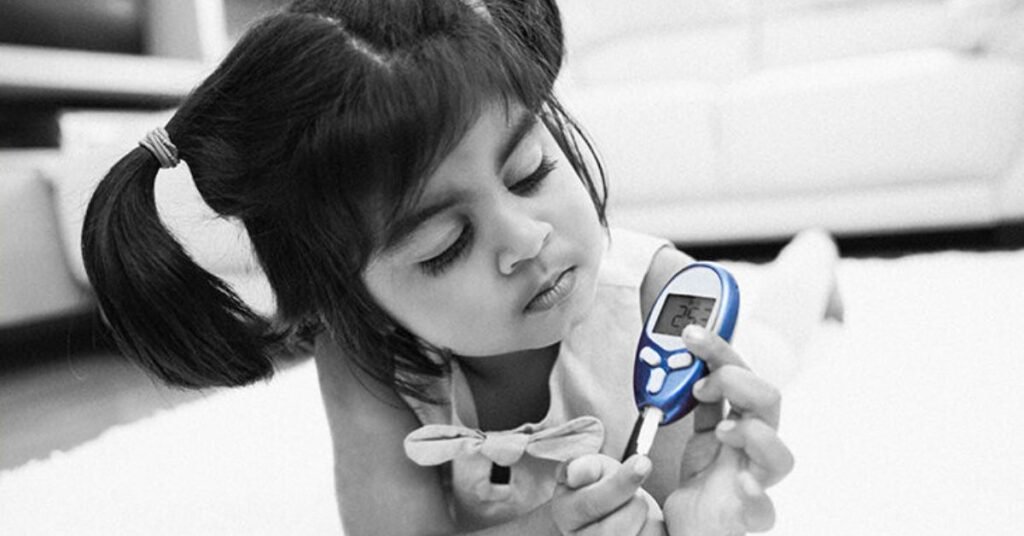why diabetes is common in kids?
In children, diabetes is undoubtedly the most common illness.
The majority of mothers are unaware that their children are impacted.
Type 2 diabetes in children is typically identified in their early teenage years.
One theory is that puberty hormones make it more difficult for the body to use insulin,
which is especially problematic for girls because they are more sensitive to type 2 diabetes than boys.
Your child’s risk of developing conditions like restricted artery walls, high blood pressure,
Heart disease, and stroke increases if they are diagnosed with diabetes at a young age.A fail of the nerves.
A child’s tiny blood vessels, which supply their nerves with oxygen and nutrients,
It can be damaged by an excessive amount of sugar.
This can lead to a variety of uncomfortable sensations, including tingling, numbness, burning, and pain.

Definition of diabetes in kids:
Diabetes is a metabolic disorder in which the body has trouble processing glucose (a form of sugar).
Carbohydrates provide glucose, the body’s primary source of energy for all of its cells.
Glucose uptake is facilitated by insulin, a hormone produced in the pancreas.

DIABETES IN CHILDREN: AT WHAT AGE?
A child’s risk of developing type 1 diabetes does not decrease with age.
your child could be diagnosed with it as a newborn, or at any point between the ages of 2 and 18.
Typically, it doesn’t show up until after a child turns 5.
But there are those who don’t realize it until their 30s.

Reason why kids get diabetes:
Too much of anything can result in negative outcomes in later life, and sugar consumption in childhood is no exception.
When consumed in large quantities, sugar causes obesity, which in turn increases a child’s risk for hypertension.
hypertension, and insulin resistance, all of which can be unavoidable.

Symptoms Of Diabetes:
In children, symptoms of type 1 diabetes often arise suddenly and may include the following:
- Improved Thirst
- Continual wetting of the bed, despite using the toilet, in a child who has been potty-trained
- Severe lack of food
- Loss of weight without trying
- Fatigue
- Mood swings or a shift in actions
- Fresh, fruity breath

Children with diabetes :
A rise in the number of gestational diabetes, shifts in how food is processed,
and declining levels of physical activity among children are all contributing factors.
There was an increase in the number of babies born to mothers with diabetes.
and those who had gestational diabetes, she added.
In addition, we know that a person’s risk of developing type 2 diabetes is affected by their genes.

Preventative measures for diabetes:
A child’s risk for developing type 2 diabetes is low, and there are many things.
you can do to help control or prevent the disease.
If you want your child to grow up healthy and strong, it’s important to instil good habits.
Like eating right, being active, and not letting weight slip.
If lifestyle changes like diet and exercise aren’t enough to manage type 2 diabetes,
medication, such as oral tablets or insulin injections, may be necessary.
Possible Dangers:
The risk of developing type 2 diabetes in children is also raised by the following factors:
inheriting the disease from a loved one who suffers from type 2 diabetes.
having a mother who has been diagnosed with gestational diabetes (diabetes while pregnant).

Suffering from insulin-related illness:
Talk to your doctor about getting your child’s blood sugar checked.
If he or she is overweight and has any two of the risk factors listed above.
The first round of testing is administered around the age of 10, or at the onset of puberty.
whichever comes first, and subsequent rounds occur every three years.

Diabetes Common in kids:
Type 1 diabetes, the most common form of the disease in children, is a chronic illness.
That requires constant treatment with insulin injections.
Those over the age of 40 are more likely to develop type 2 diabetes.
It manifests itself when insulin production and use become dysfunctional.
The incidence of type 2 diabetes is rising in the youth population, but it still hardly ever affects kids.
Conclusion:
Diabetes in kids is very common disease because kids who have overweight
or have some medical issue during pregnancy face this disease.
Diabetes requires alert monitoring and effective treatment through the use of appropriate medication.
and the adoption of a healthy lifestyle.
If we take the time to live healthily, see our doctors regularly, and take our prescribed medications.
we can expect to live long and fruitful lives.



